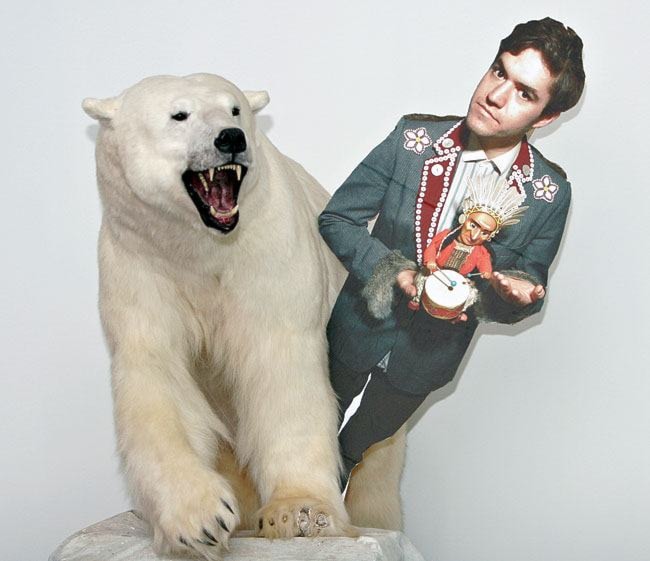Joseph Tisiga’s Indian Brand Corporation exhibition is like looking into a red, plastic viewfinder.
Like those 3-D cartoon characters, it leaps out at you as soon as you walk into the Yukon Arts Centre gallery.
So, it’s fitting that Tisiga chose a viewfinder as one of the recurring images in his show.
One part parody, two parts abstract symbolism, the local exhibition goes right for the jugular with its satirical representations of modern corporate culture.
“I wanted something a bit abrasive and jarring,” said Tisiga.
“I was interested in looking at the conditions of First Nations people and how indigenous communities are adapting to the modern world.”
First Nation culture and tradition play a prominent part in the paintings, photography, and found-art installations that make up the body of Tisiga’s work.
Most striking are a series of five paintings depicting First Nation people interacting with Archie comic-book characters.
In one painting, the sweet and nurturing Betty is wrapping a Hudson’s Bay Blanket around a young First Nations girl in a bedroom. The reference to Canada’s colonial past and residential school legacy is explicit.
In another painting, Reggie, Archie’s sly and conniving friend, stands coaxing Moose, the well-meaning meathead, to sign a document that we can only imagine is a land claim agreement. Two Europeans stand alongside gazing off at the mountains and teepees in the distance.
By lifting these historical scenes and re-imagining them in an absurdist way, Tisiga gets striking results.
The Archie characters are also a silent nod to Archibald Belaney, the famed Englishman who in the early 1900s pretended to be aboriginal, renaming himself Grey Owl. It’s a character that Tisiga parodied in his Late Nights with Grey Owl performance at Nakai’s Pivot Festival in January.
In his current exhibit, Tisiga takes the Grey Owl caricature and turns it on its head by masquerading as a First Nations person in corporate attire.
A photo series of Tisiga wearing a pinstriped suit embroidered with beading, fur and leather, and posing in several different colourless rooms, is a tongue-in-cheek reference to corporations that have appropriated cultural identities to sell their products.
A certificate for a $20 share into the Indian Brand Corporation hangs above a desk and filing cabinet in one corner of the exhibit. “Now with 20% more sage” is printed in bold at the top of the certificate. On the evening of Tisiga’s opening, friend Fiona Solon sat dressed in a 1950s-style dress selling shares to those interested in taking home a piece of the show.
Opposite the office installation is a pile of objects, some of which Tisiga recovered when he was given free reign to raid an old Council of Yukon First Nations building.
The Golden Book of Indian Crafts and Lore leans up against a plastic figurine of an Indian with a sharply hooked nose and a drum. The grey embroidered suit featured in the photo series hangs above a heap of feathers, moccasins and cigarette packages. A red, plastic viewfinder also pokes out of the mix.
“The viewfinder gives a super-simplified view of the world,” said Tisiga.
The viewfinder is similar to television in that it offers a flattened version of reality even with the three-dimensional image it boasts, he said.
A second photo series in the exhibit takes its inspiration from the toy, superimposing large, cartoonish images of feathers and traditional carvings onto saturated colour backgrounds of mountains and lakes.
The juxtaposition of stereotypical First Nation traditions alongside bland images of corporate culture throughout the show forces the viewer into a dialogue with the art.
But it is a dialogue that Tisiga wants to keep open.
“As political as the work seems, I want to keep the ideas (in the show) purposely vague,” he said.
“I’m interested in hearing what other people think of the show.”
At the opening on June 4, Tisiga opted to turn the spotlight on the audience, asking them their thoughts on the show rather than explaining the motivations behind his work.
As a visual and performance artist, Tisiga is fascinated by the way people interpret their world and the lived experiences they might use to understand a piece of work.
“There is no right or wrong way to interpret a piece of art,” he said.
“What’s important is that there is a dialogue.”
Tisiga collaborated on the show with members of the local art collective, the Red Wagon Union. Morgan Whibley does photography while the other members assist in the sound and production of a short Indian Brand Film looped at the entrance to the exhibition.
Throughout the summer Tisiga will revisit the exhibition, reorganizing and re-contextualizing pieces in the show. He also plans to do a performance piece before the exhibition wraps up on August 30.
It’s an important exhibition for Tisiga who, this past spring, received a prestigious Canada Council Art grant and was recently chosen as one of 15 finalists in a national Royal Bank of Canada art competition.
The Indian Brand Corporation exhibition seals Tisiga as rising star on the local and national stage.
Contact Vivian Belik at vivianb@yukon-news.com
